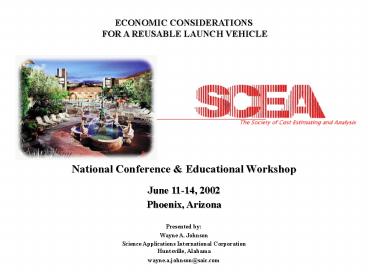ECONOMIC CONSIDERATIONS
1 / 16
Title:
ECONOMIC CONSIDERATIONS
Description:
NRA 8-30 Awards TA2-9. Program Milestones. Focused Architecture ... NRA 8-30 Award for TA1. Option 1. Base Award. Cycle II Procurement (NRA8-30 and In-House) ... – PowerPoint PPT presentation
Number of Views:67
Avg rating:3.0/5.0
Title: ECONOMIC CONSIDERATIONS
1
ECONOMIC CONSIDERATIONS FOR A REUSABLE LAUNCH
VEHICLE
National Conference Educational Workshop June
11-14, 2002 Phoenix, Arizona Presented by Wayne
A. Johnson Science Applications International
Corporation Huntsville, Alabama wayne.a.johnson_at_sa
ic.com
2
Background
- NASA Space Launch Initiative (SLI)
- Managed by NASA Marshall Space Flight Center
- 4.85B FY02-FY06
- Reusable Vehicle Concepts
- Lower Technical/Business Risks
- Increase Safety/Reliability
- Technology Development
- 22 Contracts Let Spring 2001
SLI overview animation
3
SLI Schedule
Courtesy NASA
4
Stakeholder Perspectives
Stakeholder Issues
- Industry
- - Launch Providers
- - Payload Manufacturers
- Government
- ISS Support
- Crew Rotation
- Logistics
- Asset Deployment/Recovery
- Reconnaissance
- Financiers/Backers
- Bankers
- Brokers
- - Insurers
Architecture Size Market Demand Launch
Price Safety/Reliability Replacement
Shuttle Launch Price Safety/Reliability Retu
rn on Investment Risk
5
Acquisition Phase
- DDTE Costs
- Mission Requirements
- Trade Analyses
- Prototypes/Test Units
- Production Costs
- Lean Manufacturing
- Quantities/Element
- Facilities (New/Refurbish)
- Booster/Orbiter/CTV Processing
- Mission Operations
- Runway
- Location(s)
- Temporal (Time Phasing)
- Debt Instruments
- Private/Public Debt
- Internal
- Government Loans/Guarantees
- Interest Rate
Time
6
Operations Phase
- Recurring
- - Flight Operations
- Propellants
- Labor
- Insurance
- Non-Recurring Costs
- - Ground Support Equipment
- - Facilities Upgrades
- Flight Rates
- Quantities
- Turn-Around Time
- Operating Revenues
- - Price/Flight
- Facilities
- - Mission Operations
?
7
Market Considerations
8
Market Considerations (Contd)
- RLV Faces Competition From Expendable Launch
Market - Highly Reliable Launchers
- More Launch Site Choices
- Worldwide Competition
- Government Subsidies
- Tumultuous Commercial Satellite Industry
- - Mergers Acquisitions
- - Regulatory Policies in Emerging Markets
- Uncertainty in Broadband Market
- Excess Transponder Capacity
- Terrestrial Competition
- Negligible RLV Market for Small and Heavy
Payloads - - Micro/Small Class (with Expendables
- - Heavy Payloads (25K Lbs.) Are Few Primarily
DoD - Projections for Intermediate to Large Markets
Are Flat - Long Range Forecasts are Difficult
9
Satellite Mass Growth Trend
Predicted satellite mass no greater than 20K lbs
by 2020
Source Futron, Inc.
10
Financial Metrics
- Cash Flow
- The difference between incoming revenue and
outgoing costs over a finite time period. - This is a good metric for insight into the
amount of inflows/outflows, their rates - of increase/decrease, and provides temporal
insights such as investment - recovery (break-even) time.
- Discounted Cash Flow
- A cash flow summary that has been adjusted to
reflect the time value of money. - This concept takes into account the Present
Value (PV) and Future Value (FV) - notions of financial analysis. The PV is what
future money is worth in todays terms. - Internal Rate of Return
- - The the discount rate for which total present
value of future cash flows equals the - cost of the investment. The IRR is a specific
calculated interest rate that will - produce a Net Present Value (NPV) of zero. This
is an excellent metric to use when - there is a large initial cash outlay.
- Payback Period
- The length of time required to recover the cost
of an investment, usually measured in years.
11
Cumulative Cash Flow Profile
Revenues Exceed Costs
Max. Loss Exposure
- Government can wait longer to recoup
investments industry has shorter time
impositions - Before/After Tax profiles can differ
significantly
12
Building a Shuttle Replacement Case
No Shuttle Replacement
Shuttle
Yearly Operations Cost
RLV
IOC
Time
- A replacement RLV system must prove to be less
expensive - to operate (in the long term) than continuing
Shuttle operations - Ongoing shuttle operations require safety and
performance upgrades - RLV must be more reliable and safer then Shuttle
13
A Modeling Approach
Sample Data Only
14
Sensitivity Analysis
- FSD Decision in 2006 constant fleet size
- Production, Facilities, Operations costs, Launch
Prices held constant - Steady State Operations 5 yrs Post IOC
All other factors equal, financial metrics are
sensitive to acquisition costs
15
Sensitivity Analysis
- Acquisition and operations costs held constant
- Constant market prices
- 20 years of operation post IOC
- Adequate Facility Capacity to Accommodate Higher
Flight Rates
As flight rate is doubled, IRR improves to a
maximum of 13 over the baseline
16
Summary
- Costs
- - Acquisition
- - Operations
- - Phasing
- Revenues
- - Prices
- Flight Rates
- - Mission Types
- - Processing Times
- Markets
- Elasticity
- Emerging
- Financial Metrics
- - NPV
- IRR
- Payback Period































